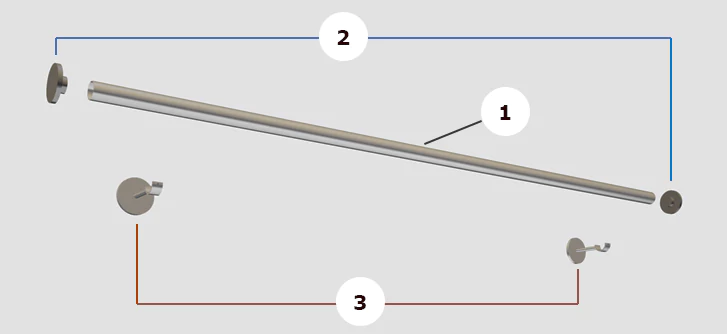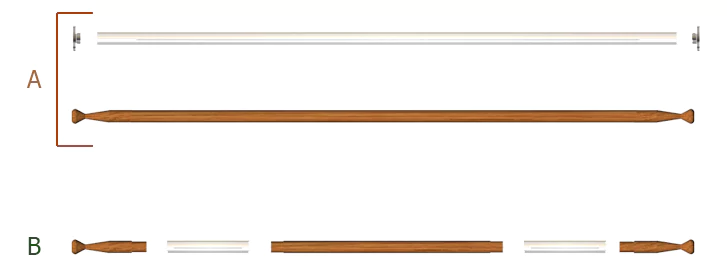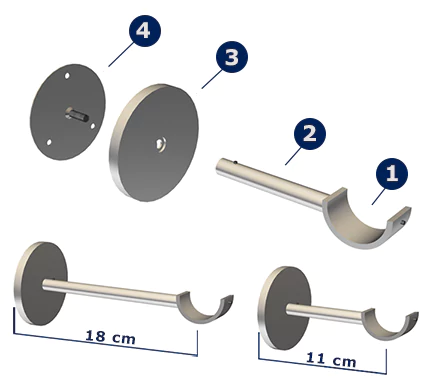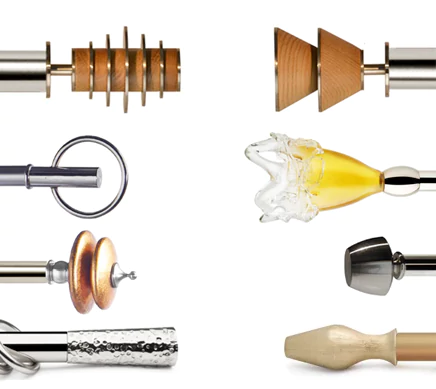How to choose your curtain rod
Introduction
Choosing the ideal curtain rod. The curtain rod is a fundamental element of interior design, and is more than just a rod for hanging fabric. The curtain rod is made up of several complementary components which, when combined, guarantee solidity, practicality and aesthetic harmony for your interior decoration. Understanding these different components allows you to make informed choices when buying or installing. On this page, we'll explore in detail each of the components that make up a curtain rod.
Components of curtain rods:
 (Fig.1 ) 1- The bar; 2- The Finials; 3- The Brackets;
(Fig.1 ) 1- The bar; 2- The Finials; 3- The Brackets;
1. The pole
The centrepiece of a curtain rod is the bar or rod itself. It can be made of metal or wood. The length of the rod must be adapted to the width of the window, often with an extension to cover the entire width or to allow the curtain to be opened without hindrance.
Types of poles
1.1. The straight pole: The straight curtain rod is the most common and simplest type. It consists of a linear bar, often made of metal or wood, fixed horizontally above the window.
 Fig. 2 Differences between the conventional curtain poles (A) and Getynd curtain rods (B).
Fig. 2 Differences between the conventional curtain poles (A) and Getynd curtain rods (B).
Conventional curtain rail rods are made from a single piece, in one piece (Fig.2 A). At Absolute Deco, our rods are made up of several segments in different types of metal with different finishes (Fig.2 B), as well as solid wood sticks, offering a product that is both robust and decorative. Find out more, see page " The Getynd Concept" .
1.2. The curved or bent bar: This type of rod is designed with a curvature, allowing the curtain to unfold in an arc or curve. It is often used for curved or atypically shaped windows, or to create a particular aesthetic effect.
1.3. The extendable bar: This type of rod has an adjustable bar that can be extended or retracted according to the width of the window.
2. Curtain rail brackets
 (Fig.3 ) 1- Bracket; 2- Bracket rod; 3- Decorative plate; 4- Fixing plate;
(Fig.3 ) 1- Bracket; 2- Bracket rod; 3- Decorative plate; 4- Fixing plate;
The brackets play a crucial role in holding the rod in place by fixing to the wall or ceiling, depending on the configuration. The rod's strength and stability depend on the quality and fixing of these brackets. There are several types: single wall brackets, double brackets, ceiling brackets, side brackets (installed between walls), central brackets, etc.
2.1. Types of support mounting plates: two or three fixing points?
The brackets fixing plates are very important for ensuring the stability and safety of the curtain poles. As a general rule, larger diameter brackets have three fixing points on the wall, while smaller diameter brackets have two. In fact, brackets with two fixing points (standard) provide good stability, especially for medium-length curtain poles and light to medium-weight curtains.
Specialists particularly recommend three-point fixing plates for long curtain poles or for supporting heavy curtains. Using three fixing points distributes the weight even more evenly. It also strengthens the fixing, making it more resistant to wear and tear and the stresses of everyday life.
2.2. Length of support rod.
Another important detail about wall brackets is the length of the bracket rod, which determines the distance between the curtain rod and the wall.

3. Finials
The finials are decorative elements placed at each end of the rod. They prevent the curtains from sliding off the rod and add an aesthetic touch. Available in a wide variety of styles, they can be made of metal, wood, glass, etc., in classic, modern or artistic shapes. Their choice depends on your interior design style.
Conclusion
By mastering these elements, you can personalise your space in a functional and elegant way, for an interior that reflects who you are.
Now it's easier than ever to choose the perfect curtain rod for your space. Make your choice today in our shop.